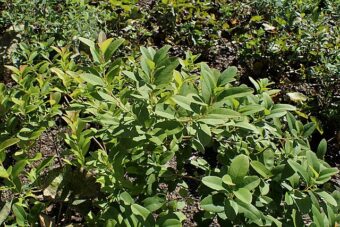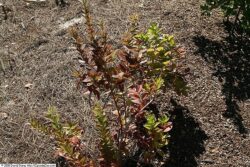In this article, we will be discussing how to grow Zenobia in containers. Zenobia or Honeycup to give its common name is the only species of shrub that belong to the Ericaceae (the Erica) family. It is found naturally growing in North America, where the only species is Zenobia pulverulenta (Syn. Z. speciosa).
This is one of the species that love acidic soils and does well with other classic lime haters such as Rhododendrons, Camellias, Callunas and Pieris. It is not common in the UK garden, which is surprising as it is easy to grow. Looks good growing above Heathers and below Rhododendrons in a native acid-loving, woodland container scheme.

Zenobia is a hairless shrub whose leaves are covered with a waxy coating. In spring, the young stems have a distinct silvery bloom, which disappears as the 5cm long oval, green leaves as it mature. In autumn both the stems and some of the foliage turn orange or red. This semi-evergreen shrub will lose part of its leaves every autumn. It is interesting to see the colour changes of the leaves and stems from spring to autumn, autumn to spring, This is not why the shrub is grown for, but instead, the pendant white flowers that are 12cm wide, are. It looks like a large group of lily of valley blooms and they have an aniseed-like scent. Each flower produces up to 200 egg-shaped seeds in a dry capsule.
Find out how to grow the shrub of Zenobia in containers.
GROWING ZENOBIA IN CONTAINERS
First, choose a large enough container that is well-balanced with the shrub in question and will suit it. Make sure it has plenty of drainage holes at the bottom. To this container add a 2cm layer of gravel to aid drainage even further. On top of this add ericaceous compost to within 5cm of the top rim of the container. It is important that you use ericaceous compost as it hates alkaline soil.

Dig a hole in the centre of the container slightly bigger than the root ball it came in the original pot you purchased the plant in. Place the plant in the hole so that the top of the root ball is at the same level as the top surface of the compost in the container. Backfill the growing media so that no vacant spaces remain, using more compost if you find it necessary.
Firm the plant in and water well.
THE BEST GROWING CONDITIONS
Place the shrub and container in a sheltered spot in the shade, they prefer for the compost to be moist at all times, so as soon as the compost feels dry to the touch, it is time to water. When you water make sure you do it with rainwater to keep the pH from rising, especially if you use hard water. Water frequently, especially if hot and dry weather is being forecasted.

Every spring you will need to feed the shrub with a slow-release, ericaceous compost to give enough nutrients to last the whole growing season, no additional feeding will be required.
Pruning is not necessary at all but you can remove spent flowering stems when the blooms have faded.
To propagate you can do this by planting seeds in late winter outdoors or better still is to layer shoots in spring. A final method is to take semi-ripe cuttings in a cold frame in summer.
PESTS AND DISEASES
Luckily this is one shrub that does not suffer from pests and diseases, but they can suffer from chlorosis if manganese and/or iron is deprived of the plant. To stop this, you can feed in spring with a slow-release, ericaceous fertilizer to which a handful of sulphate of iron has been added.
VARIETIES TO GROW
The only species that you can find as said in the introduction is Zenobia pulverulenta, which has been described in the introduction.
The only likely variety you will find is ‘Blue Sky’ which has a bluish tint to the leaves.
CONCLUSIONS
In this article, we have discovered how to grow the rare flowering shrub of Zenobia in containers. They are easy to care for, look after and do not suffer from pests and diseases. They even do not need to be pruned at all, so what is not to like?
If you have any questions or comments that you wish to make on growing Zenobia in containers, please do so in the comment box below.
Happy Zenobia growing.
